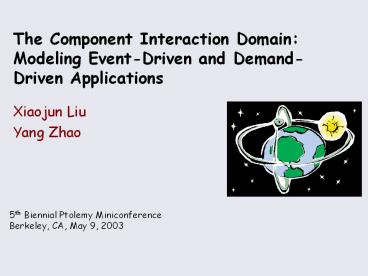The Component Interaction Domain: Modeling Event-Driven and Demand-Driven Applications PowerPoint PPT Presentation
1 / 18
Title: The Component Interaction Domain: Modeling Event-Driven and Demand-Driven Applications
1
The Component Interaction Domain Modeling
Event-Driven and Demand-Driven Applications
- Xiaojun Liu
- Yang Zhao
2
Outline
- Interaction between Software Components
- Software Framework Examples
- The CORBA Event Service
- The Click Modular Router
- The Component Interaction (CI) Domain
- Demonstration
- Current Status and Future Work
3
Aspects of Component Interaction
- Making sense of the information exchanged
- E.g. a pure event notification, or an array of
floating-point numbers - Managed by the type system
- The communication protocol
- E.g. rendezvous, or read from/write to a FIFO
queue - Managed by a model of computation
4
Aspects of Component Interaction
- Initiation
- Which participant initiates the interaction?
- What components can initiate interaction?
- Control flow
- How do interacting components obtain the
execution context? - Timing
5
The CORBA Event Service
- Support asynchronous, decoupled communication
between objects
6
The Push Model
Consumer
push()
Supplier
push()
Event Channel
push()
Consumer
Supplier
push()
Consumer
push()
- The supplier initiates the transfer of data
- The consumer reacts to supplied data
- The event channel provides the execution context
for the consumer
7
The Pull Model
Consumer
pull()
Supplier
pull()
Event Channel
pull()
Consumer
Supplier
pull()
Consumer
pull()
- The consumer initiates the transfer of data
- The supplier reacts to demand of data
- The event channel provides the execution context
for the supplier
8
Mixed Models
- Push supplier and pull consumer
- The event channel acts as an event queue
- Pull supplier and push consumer
- The event channel must act as an active mediator
for any interaction to take place
Event Channel
Supplier
Consumer
push()
pull()
Event Channel
Supplier
Consumer
push()
pull()
9
Complex Mixture
Consumer
pull()
pull()
Event Channel
Supplier
push()
Event Channel
Consumer
push()
push()
pull()
Supplier/ Consumer
push()
pull()
Supplier/ Consumer
Supplier/ Consumer
pull()
pull()
Event Channel
Supplier
Supplier/ Consumer
Event Channel
push()
push()
push()
pull()
pull()
Supplier
Consumer
10
The Click Modular Router
- Elements are C objects that interact by making
method calls - Packets are passed as method argument or return
value - Flexible, configurable, and highly efficient
routers have been built with this software
architecture
E. Kohler et al., The Click Modular Router, ACM
Transactions on Computer Systems, 18(3), August
2000, pages 263-297.
11
The Component Interaction Domain
- Push/pull interaction
- Active/passive actors
- Multi-threaded execution
12
Push/Pull Interaction
- Push model
- Event-driven applications
- Pull model
- Demand-driven applications
13
Active Actors
- Active actors initiate all computation in the
model - Source actors with push output
- Sink actors with pull input
- Actors with pull input and push output
14
Passive Actors
- Passive actors react to pushed event or pull
demand
15
Multi-Threaded Execution
- Each active actor has its own execution thread
- Passive actors share the same execution thread as
the director
16
A Router Model in the CI Domain
17
CI vs. the Click Router Architecture
- Click is a specialized, highly efficient, runtime
software architecture based on object-oriented
programming. Router elements interact by making
method calls. The control flow is fixed once the
router is built. - The CI domain provides a more general model
architecture based on actor-oriented programming.
Actor interaction is mediated by the director, so
is more decoupled. The director (or code
generator) can partition a model and choose a
different analysis/scheduling strategy for each
part.
18
Current Status and Future Work
- Current status
- A preliminary implementation is included in the
current release - Future work
- Design the infrastructure for building actors
with mixed push/pull input ports and output ports - Partitioning of CI models for scheduling and
allocating execution threads - Explore the relation to dynamic dataflow that
uses both data-driven and demand-driven execution
strategies

